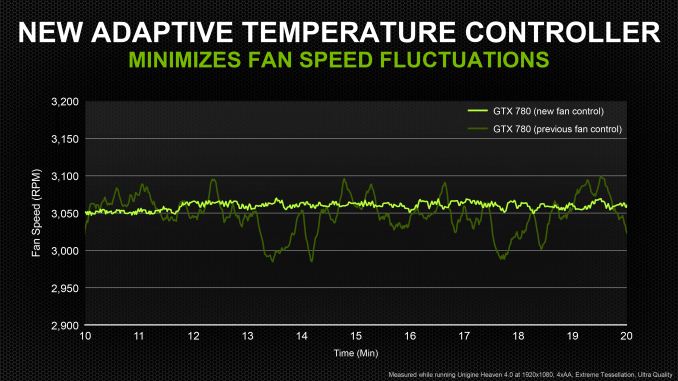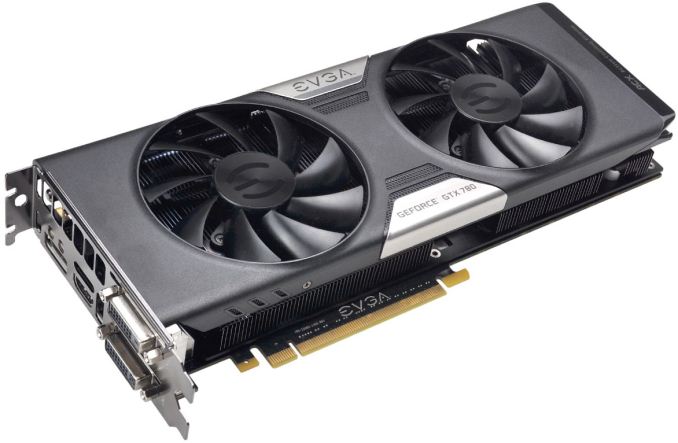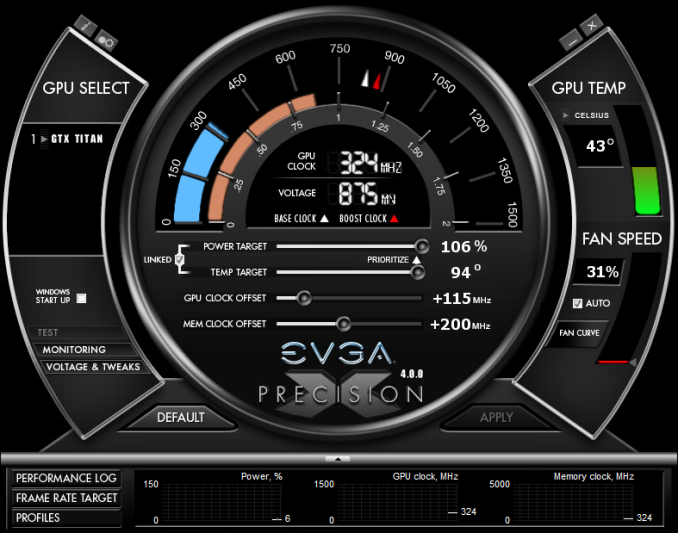NVIDIA GeForce GTX 780 Review: The New High End
by Ryan Smith on May 23, 2013 9:00 AM ESTMeet The GeForce GTX 780, Cont
With all of that said, GTX 780 does make one notable deviation from GTX Titan. NVIDIA has changed their stock fan programming for GTX 780, essentially slowing down the fan response time to even out fluctuations in fan speeds. NVIDIA has told us that they’ve found that next to loud fans in general, the second most important factor in fan noise becoming noticeable is rapidly changing fan speeds, with the changing pitch and volume drawing attention to the card. Slowing down the response time in turn will in theory keep the fan speed from spiking so much, or quickly dropping (i.e. loading screen) only to have to immediately jump back up again.
In our experience fan response times haven’t been an issue with Titan or past NVIDIA cards, and we’d be hard pressed to tell the difference between GTX 780 and Titan. With that said there’s nothing to lose from this change, GTX 780 doesn’t seem to be in any way worse for it, so in our eyes there’s no reason for NVIDIA not to go ahead with the change.
On that note, since this is purely a software(BIOS) change, we asked NVIDIA about whether this could be backported to the hardware equivalent Titan. The answer is fundamentally yes, but because NVIDIA doesn’t have a backup BIOS system, they aren’t keen on using BIOS flashing any more than necessary. So an official (or even unofficial) update from NVIDIA is unlikely, but given the user community’s adept BIOS modding skills it’s always possible a 3rd party could accomplish this on their own.
Moving on, unlike Titan and GTX 690, NVIDIA will be allowing partners to customize GTX 780, making this the first line of GK110 cards to allow customization. Potential buyers that were for whatever reason disinterested in Titan due to its blower will find that NVIDIA’s partners are already putting together more traditional open air cooler coolers for GTX 780. We can’t share any data about them yet – today is all about the reference card – but we already have one such card in-hand with EVGA’s GeForce GTX 780 ACX.
The reference GTX 780 sets a very high bar in terms of build quality and performance, so it will be interesting to see what NVIDIA’s partners can come up with. With NVIDIA testing and approving all designs under their Greenlight program, all custom cards have to meet or beat NVIDIA’s reference card in factors such as noise and power delivery, which for GTX 780 will not be an easy feat. However because of this requirement it means NVIDIA’s partners can deviate from NVIDIA’s reference design without buyers needing to be concerned that custom cards are significantly worse than then reference cards, something that benefits NVIDIA’s partners by their being able to attest to the quality of their products (“it got through Greenlight”), and benefitting buyers by letting them know they’re getting something that will be as good as the reference GTX 780, regardless of the specific make or model.
On that note, since we’re talking about card construction let’s quickly dive into overclocking. Overclocking is essentially unchanged from GTX Titan, especially since everything so far is using the reference PCB. The maximum power target remains at 106% (265W) and the maximum temperature target remains at 95C. Buyers will be able to adjust these as they please through Precision X and other tools, but no more than they already could on Titan, which means overclocking is fairly locked down.
Overvolting is also supported in a Titan-like manner, and once again is at the discretion of the card’s partner. By default GTX 780 has a maximum voltage of 1.1625v, with approved overvolting allowing the card to be pushed to 1.2v. This comes in the form of higher boost bins, so enabling overvolting is equivalent to unlocking a +13MHz bin and a +26MHz bin and their requisite voltages. However this also means that those voltages aren’t typically reached with overclocking and overvolting only has a minimal effect, as most overclocking attempts are going to hit TDP limits before they hit the unlocked boost bins.
| GeForce Clockspeed Bins | ||||
| Clockspeed | GTX Titan | GTX 780 | ||
| 1032MHz | N/A | 1.2v | ||
| 1019MHz | 1.2v | 1.175v | ||
| 1006MHz | 1.175v | 1.1625v | ||
| 992MHz | 1.1625v | 1.15v | ||
| 979MHz | 1.15v | 1.137v | ||
| 966MHz | 1.137v | 1.125v | ||
| 953MHz | 1.125v | 1.112v | ||
| 940MHz | 1.112v | 1.1v | ||
| 927MHz | 1.1v | 1.087v | ||
| 914MHz | 1.087v | 1.075v | ||













155 Comments
View All Comments
varad - Thursday, May 23, 2013 - link
You do realize that a GPU like Titan has almost 5 times the number of transistors compared to Intel's biggest Core i7 CPU, right? There are 7.1 billion transistors in Titan vs 1.4 billion in Core i7 3770k. So, it means they cannot match the price of "a good CPU" unless they decide to become a non-profit organization :)AssBall - Thursday, May 23, 2013 - link
Well if all you needed was a single titan to run your is, computations, games, and nothing else, then no problem.krutou - Sunday, May 26, 2013 - link
Two problems with your logic22 nm fabrication is more expensive (price per transistor)
CPUs are more difficult to design
An00bis - Friday, May 31, 2013 - link
it's not like you can just shove your hand in a jar full of transistors and just slap it on a chip and consider it a cpu, a cpu is required to do a gpu's task (integrated gpu) AND be good at everything a gpu can't do, which is... well lots of things actually. A gpu is much simpler, hence why the manufacturing + designing cost is probably more expensive than a big ass card that has to include memory+a pcb+a gpuchizow - Thursday, May 23, 2013 - link
Great card, but a year late. This is what GTX 600 series should've been but we all know how that went.I think Nvidia made some pretty big mistakes with how they handled the entire Kepler generation after Tahiti's launch price debacle. I know their financial statements and stockholders don't agree but they've managed to piss off their core consumers at every performance segment.
Titan owners have to feel absolutely gutted at this point having paid $1000 for a part that is only ~10-15% faster than the GTX 780. End result of this generation is we are effectively paying 50-100% more for the same class of card than previous generations. While the 780 is a great card and a relatively good value compared to Titan, we're still paying $650 for what is effectively Kepler's version of the GTX 470.
Crisium - Thursday, May 23, 2013 - link
People who bought a Titan knew what they were getting into. If you have regrets, you were in no position to buy a $1000 GPU to begin with and made a grievous financial error.$650 isn't horrible for this price, but you are still paying the Nvidia Tax.
chizow - Thursday, May 23, 2013 - link
I don't think so, if you polled GTX Titan owners if they would've paid $1000 knowing 2-3 months later there would be a part that performed similarly at 35% less price, I think you would hear most of them would've waited to buy not 1, but 2 for just a bit more. Or instead of buying 2 Titans, buying 3x780s.Also, it really has nothing to do with being in a financial position or not, it's funny when Titan released I made the comment anyone interested in Titan would be better served by simply investing that money into Nvidia stock, letting that money grow on Titan's fat margins, and then buying 2x780s when they released. All according to plan, for my initial investment of 1 Titan I can buy 2x780s.
But I won't. Nvidia blew it this generation, I'll wait for Maxwell.
IanCutress - Thursday, May 23, 2013 - link
Titan was a compute card with optional gaming, rather than a gaming card with optional FP64 compute. That's why the price difference exists. If you bought a Titan card for Gaming, then you would/should have been smart enough to know that a similar card without compute was around the corner.chizow - Thursday, May 23, 2013 - link
Unfortunately, that was never how *GTX* Titan was marketed, straight from the horses mouth:"With the DNA of the world’s fastest supercomputer and the soul of NVIDIA® Kepler™ architecture, GeForce® GTX TITAN GPU is a revolution in PC gaming performance."
Not to mention the fact Titan is a horrible compute card and value outside of CUDA workloads, and even there it suffers as a serious compute card due to the lack of ECC. It's an overpriced gaming card, plain and simple.
At the time, it was still uncertain whether or not Nvidia would launch more SKUs based on GK110 ASIC, but informed consumers knew Nvidia had to do something with all the chips that didn't make the TDP cut as Tesla parts.
mayankleoboy1 - Thursday, May 23, 2013 - link
Really ? Apart from a few apps, Titan is poor compared to a 7970. It has bad OpenGL performance, which 90% of industry renderfarms use.Titan is really an overpriced gaming card.